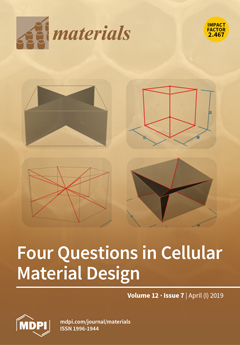Based on semi-solid mixing technology, two kinds of as-cast Grp (Graphite particles)/AZ91 composites with different Grp volume fractions (5 vol %, 10 vol %) were prepared; these are called 5 vol % Grp/AZ91 composites and 10 vol % Grp/AZ91 composites, respectively. In order
[...] Read more.
Based on semi-solid mixing technology, two kinds of as-cast Grp (Graphite particles)/AZ91 composites with different Grp volume fractions (5 vol %, 10 vol %) were prepared; these are called 5 vol % Grp/AZ91 composites and 10 vol % Grp/AZ91 composites, respectively. In order to eliminate casting defects, refine grains, and improve mechanical properties, thermal deformation analysis of these composites was conducted. The effect of the addition of Grp and thermal deformation on the microstructure, mechanical properties, and wear resistance of AZ91 composite was explored. The results showed that after 5 vol % Grp was added into the as-cast AZ91 alloy, Mg
17Al
12 phases were no longer precipitated reticularly along the grain boundary, and Al
4C
3 phases were formed inside the composite. With the increase in the volume fraction of Grp, the grains of the AZ91 composites were steadily refined. With the increase of forging pass, the grain size of 5% Grp/AZ91 composites decreased first, and then increased. Additionally, the Grp size decreased gradually. There was little change in the yield strength, and the tensile strength and elongation were improved to a certain extent. After forging and extrusion of 5% Grp/AZ91 composites once, the grain size and Grp size were further reduced, and the yield strength, tensile strength, and elongation were increased by 23%, 30%, and 65%, respectively, compared with the composite after forging. With the increase of the number of forging passes before extrusion, the grain size decreased little by little, while the Grp size remained unchanged. The average yield strength, tensile strength, and elongation of the composites after forging and extrusion six times were increased by 3%, 3%, and 23%, respectively, compared with the composite after forging and extrusion once. The wear rate and friction coefficient of the 5% Grp/AZ91 composites decreased after forging once, and the wear mechanism was mainly due to ploughing wear. By comparison, the wear rate and friction coefficient of the 5% Grp/AZ91 composites increased in the extrusion state, and the main wear mechanism was from wedge formation and micro-cutting wear.
Full article






